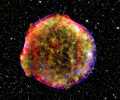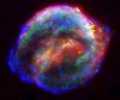


Type I Supernovae
Introduction
Astronomers identify the different clsses of Type l supernovae by their spectra, as shown in the following table:
| Type | Comments |
| Type la | The spectrum shows singly ionized silicon, but no hydrogen. |
| Type lb | The spectrum shows non-ionized helium, but lacks any strong evidence of silicon, and no hydrogen. |
| Type lc | The spectrum shows little or no helium or silicon, and no hydrogen. |
SN 1572
SN 1604
Astronomy & Cosmology -
Stars - Life & Death of Stars
Type Ia
This phenomenon starts in a similar way to the Nova model described in the previous section. The difference is that when the white dwarf accretes enough material from its companion to approach the Chandrasekhar Limit, which is about 1.4 times the mass of the Sun, it can no longer support its mass. The increasing temperature and density at the core causes carbon fusion to start once the star is within about 1% of the Chandrasekhar Limit, and almost immediately most of the material comprising the white dwarf undergoes nuclear fusion, releasing enough energy to explode itself in a type 1a supernova. Material is ejected at up to 3% of the speed of light, with a colossal increase in brightness until it is about 5 billion times brighter than the Sun. Because this type of supernova always occurs at the same mass, in non-revolving stars, the intrinsic brightness of the explosion is always the same. Any variation in apparent brightness is, therefore, attributable to the distance to the white dwarf. This allows astronomers to use type 1a supernovae as what is known as a "Standard Candle" as the distance can be determined very accurately. The situation with revolving stars does, however, complicate the issue, and has cast some doubt on the efficacy of this model.
The images to the right show two Type 1a supernova remnants. The upper image, SN 1572, was first observed to have exploded in November 1572 and remained visible to the naked eye in 1574. Tycho Brahe was one of many observers, though his historical record is perhaps the most comprehensive. The remnant was found first as a radio source in 1952, and was first observed optically in the 1960s. In October 2004, a G2 type star, similar to our Sun, was identified as the possible companion to the supernova star that provided the additional mass. Prior to loosing part of its mass, it would have been a larger main sequence star or perhaps a sub-giant. This is shown in the middle image. The remnant is about 7,500 light-years away in the Milky Way galaxy.
The lower image is of SN 1604, which was first observed in October 1604, and remained visible for 18 months. It is the last supernova observed within the Milky Way, and is about 20,000 light-years away. It is often called Kepler's Star because of the detailed information Kepler supplied from observing the supernova.
Type Ib & 1c
These are also known as as stripped core-collapse supernovae. They result from the collapse of the core in massive stars. These stars have lost virtually all of their outer envelope of hydrogen and, in the case of a type lc the helium envelope as well. Unlike type ll supernovae, that are also a type of core-collapse supernova, type lb and lc do not show any hydrogen in their spectra. Due to their forming from rare, massive stars, they occur much less frequently than type ll supernovae, though the actual mechanism involved is very similar for both types.
Once a massive star gets old, it has evolved several layers where fusion is occurring via different elements. Hydrogen fusion into helium in the outer layer, then helium, carbon, etc with an iron core. They may loose the outer layers through depletion caused by a strong solar wind, or, through gravity, to a close companion star.
The image to the right is of the type lb supernova SN 2008D, which occurred in the galaxy NGC 2770 in January 2008. An x-ray image is shown on the left, and visible light on the right. Credit: NASA/Swift Science Team/Stefan Immler.





